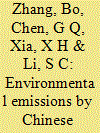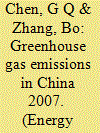|
|
|
Sort Order |
|
|
|
Items / Page
|
|
|
|
|
|
|
| Srl | Item |
| 1 |
ID:
105770


|
|
|
|
|
| Publication |
2011.
|
| Summary/Abstract |
For the Chinese industry as the mainstay of the national economy and dominant energy user and carbon emitter, an integrative assessment is performed from major energy policy perspectives of energy security, energy efficiency and carbon emission. Extensive systems indicators, including oil dependence ratio, average oil growth rate; indices of energy diversity, of carbonization and of oil growth risk; ratios of energy use to output, to value added and to compensation for laborers; ratios of carbon emission to output, to value added and to compensation for laborers, are devised to assess the Chinese industry 2002-2007 with most recent statistics availability. Combined indicators are identified by sparse principle component analysis to characterize sector performances. The industrial sectors are classified into five clusters and the main features of each cluster are pinpointed using fuzzy clustering algorithm. Concrete results facilitate comparisons of sectors to enable more accurate policy recommendations.
|
|
|
|
|
|
|
|
|
|
|
|
|
|
|
|
| 2 |
ID:
113460


|
|
|
|
|
| Publication |
2012.
|
| Summary/Abstract |
Based on chemical exergy as an objective measure for the chemical deviation between the emission and the environment, a unifying assessment is carried out for major environmental emissions covering COD, ammonia nitrogen, SO2, soot, dust, NOx and solid waste by Chinese industry over 1997-2006, with emphasis on the sectoral and regional levels in 2006. Of the total emission in exergy up to 274.1 PJ in 2006, 67.7% is estimated from waste gases, 29.9% from waste water and 2.4% from solid waste. Five of 40 sectors and 12 of 30 regions are responsible for 72.7% and 65.5% of the total emission, respectively. SO2 is the leading emission type in 9 sectors and 25 regions, and COD in another 28 sectors and 5 regions. Some pollution-intensive sectors such as Production and Distribution of Electric Power and Heat Power and Manufacture of Paper and Paper Products, and western and inland regions such as Guangxi and Ningxia with high emission intensities are identified. By clustering and disjoint principal component analysis with intensities of emissions and fuel coal use as variables, three principal components are extracted, and four statistically significant clusters are pinpointed in the sectoral and regional analysis. Corresponding policy-making implications are addressed.
|
|
|
|
|
|
|
|
|
|
|
|
|
|
|
|
| 3 |
ID:
098692


|
|
|
|
|
| Publication |
2010.
|
| Summary/Abstract |
For greenhouse gas (GHG) emissions by the Chinese economy in 2007 with the most recent statistics availability, a concrete inventory covering CO2, CH4, and N2O is composed and associated with an input-output analysis to reveal the emission embodiment in final consumption and international trade. The estimated total direct GHG emission amounts to 7456.12 Mt CO2-eq by the commonly referred IPCC global warming potentials, with 63.39% from energy-related CO2, 22.31% from non-energy-related CO2, 11.15% from CH4 and 3.15% from N2O. Responsible for 81.32% of the total GHG emissions are the five sectors of the Electric Power/Steam and Hot Water Production and Supply, Smelting and Pressing of Ferrous and Nonferrous Metals, Nonmetal Mineral Products, Agriculture, and Coal Mining and Dressing, with distinctive emission structures. The sector of Construction holds the top GHG emissions embodied in both domestic production and consumption, and the emission embodied in gross capital formation is prominently more than those in other components of the final consumption characterized by extensive investment in contrast to limited household consumption. China is a net exporter of embodied GHG emissions, with emissions embodied in exports of 3060.18 Mt CO2-eq, in magnitude up to 41.04% of the total direct emission.
|
|
|
|
|
|
|
|
|
|
|
|
|
|
|
|
| 4 |
ID:
126616


|
|
|
|
|
| Publication |
2013.
|
| Summary/Abstract |
To systematically reveal how domestic trade impacts on China's regional energy uses, an interprovincial input-output modeling is carried out to address demand-derived energy requirements for the regional economies in 2007 based on the recently available data. Both the energy uses embodied in final demand and interregional trade are investigated from the regional and sectoral insights. Significant net transfers of embodied energy flows are identified from the central and western areas to the eastern area via interregional trade. Shanxi is the largest energy producer and interregional embodied energy deficit receiver, in contrast to Guangdong as the largest energy user and surplus receiver. By considering the impacts of interregional trade, the energy uses of most eastern regions increase remarkably. For instance, Shanghai, Hainan, Zhejiang, Beijing, Jiangsu and Guangdong have their embodied energy requirements 87.49, 19.97, 13.64, 12.60, 6.46 and 6.38 times of their direct energy inputs, respectively. In contrast, the embodied energy uses of some central and western regions such as Inner Mongolia, Shanxi, Xinjiang, Shaanxi and Guizhou decrease largely. The results help understand the hidden network linkages of interregional embodied energy flows and provide critical insight to amend China's current end-reduction-oriented energy policies by addressing the problem of regional responsibility transfer.
|
|
|
|
|
|
|
|
|
|
|
|
|
|
|
|
| 5 |
ID:
110438


|
|
|
|
|
| Publication |
2011.
|
| Summary/Abstract |
The large-scale wind power development in China has reached a bottleneck of grid integrating capability. As a result, excess wind electricity has to be rejected in the nighttime low demand hours, when the wind power is ramping up. To compensate for the fluctuation of wind power, new coal-fired power plants are being constructed along with the big wind projects in the North China grids. This study analyzed why adding coal-fired generation cannot remove the bottleneck of wind integration by modeling the operating problem of the wind integration. The peak-load adjusting factor of the regional grid is defined. Building more coal-fired power plants will not increase the adjusting factor of the current grid. Although it does help to increase the total integrated wind power in the short term, it will add difficulties to the long-term wind integration. Alternatively, the coordinated resource utilization is then suggested with the discussion of both the effective pumped hydro storage and the potential electric vehicle storage.
|
|
|
|
|
|
|
|
|
|
|
|
|
|
|
|
| 6 |
ID:
119203


|
|
|
|
|
| Publication |
2013.
|
| Summary/Abstract |
We identify the difference in market characteristics between different regions as an important determinant of the entry mode choices of foreign banks. The greater the difference in borrower quality between the developed and underdeveloped regions is, the more likely that the foreign bank to pursue Greenfield investment in the developed region. However, if the relative market size or the amount of borrowers in the underdeveloped region is large enough, the foreign bank tends to take stakes in a domestic bank operating in the underdeveloped region. Our findings provide valuable insights for explain observed organizational forms of foreign banks in China.
|
|
|
|
|
|
|
|
|
|
|
|
|
|
|
|
| 7 |
ID:
097277


|
|
|
|
|
| Publication |
2010.
|
| Summary/Abstract |
Concrete inventories for methane emissions and associated embodied emissions in production, consumption, and international trade are presented in this paper for the mainland Chinese economy in 2007 with most recent availability of relevant environmental resources statistics and the input-output table. The total CH4 emission by Chinese economy 2007 estimated as 39,592.70 Gg is equivalent to three quarters of China's CO2 emission from fuel combustion by the global thermodynamic potentials, and even by the commonly referred lower IPCC global warming potentials is equivalent to one sixth of China's CO2 emission from fuel combustion and greater than the CO2 emissions from fuel combustion of many economically developed countries such as UK, Canada, and Germany. Agricultural activities and coal mining are the dominant direct emission sources, and the sector of Construction holds the top embodied emissions in both production and consumption. The emission embodied in gross capital formation is more than those in other components of final demand characterized by extensive investment and limited consumption. China is a net exporter of embodied CH4 emissions with the emission embodied in exports of 14,021.80 Gg, in magnitude up to 35.42% of the total direct emission. China's exports of textile products, industrial raw materials, and primary machinery and equipment products have a significant impact on its net embodied emissions of international trade balance. Corresponding policy measures such as agricultural carbon-reduction strategies, coalbed methane recovery, export-oriented and low value added industry adjustment, and low carbon energy polices to methane emission mitigation are addressed.
|
|
|
|
|
|
|
|
|
|
|
|
|
|
|
|
|
|
|
|
|